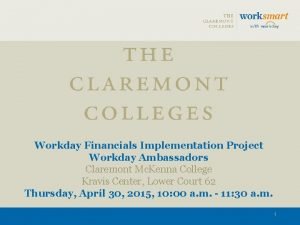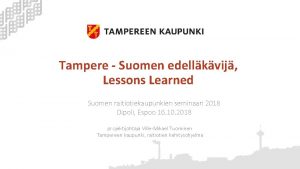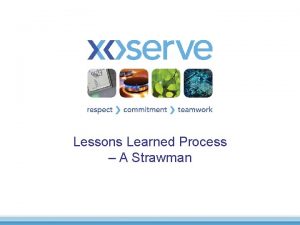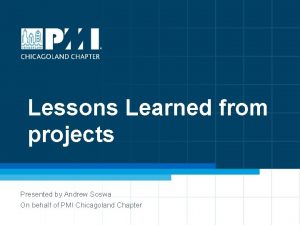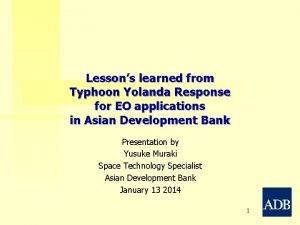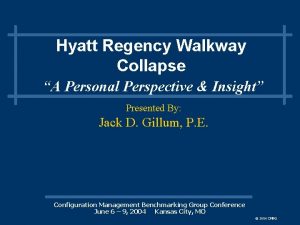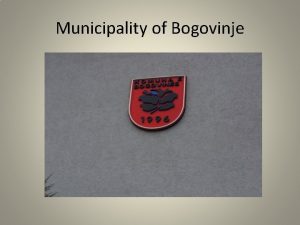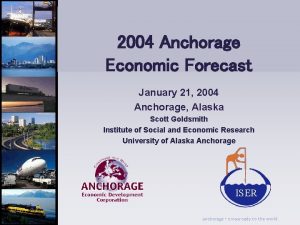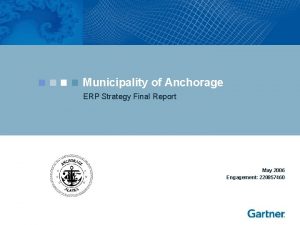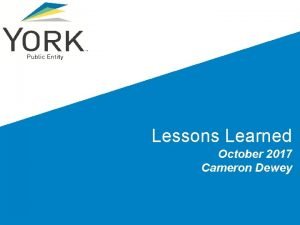Municipality of Anchorage Lessons Learned from the 2018














- Slides: 14

Municipality of Anchorage Lessons Learned from the 2018 Earthquake Alden Thern, Municipal Projects Director

Municipality of Anchorage Overview

Municipality of Anchorage Overview

Pt. Mc. Kenzie Earthquake

Federal Assistance Overview Individuals Municipality

FEMA Public Assistance (PA)

PA Lessons: Procurement Frequent Sources of Non-Compliance Issues 1. Time & Materials Contracts. T&M contracts can be used for a reasonable amount of time when no other contract type is suitable; and the contract includes a ceiling that the contractor exceeds at its own risk. Non-federal entities must also maintain a high degree of oversight (§ 200. 318(j)). 2. Cost-Plus-Percentage-of-Cost Contracts. These are contracts where the contractor’s profit is based on a percentage of the underlying project costs actually incurred. Such contracts are explicitly prohibited by the Federal procurement standards and ineligible for FEMA grant funding (§ 200. 323(d)). 3. Piggybacking. Adopting a pre-existing contract solicited and awarded by another entity is referred to as “piggybacking. ” Nonstate applicants considering piggybacking should closely examine whether use of another jurisdiction’s contract would violate the federal procurement standards, as often these contracts do not contain required assignability clauses, are improper in scope, or were not procured in compliance with the federal procurement standards (§ 200. 319). 4. Geographic Preferences. Non-state applicants must conduct procurements in a manner that prohibits the use of statutorily or administratively imposed state, local, or tribal geographical preferences in the evaluation of bids or proposals (§ 200. 323(b)). 5. Awarding to Contractors that Drafted Solicitation Documents. Non-state applicants must prohibit contractors that develop or draft specifications, requirements, statements of work, invitations for bid or requests for proposal from competing for and being awarded the subsequent contract for that work (§ 200. 323(a)). 6. Failure to reach out to small, minority-owned, women’s business enterprises. 7. Suspended or Debarred Contractors. Non-state applicants may not award a contract to a suspended or debarred contractor, nor may any prime contractor award to a suspended or debarred subcontractor. Check the database at www. sam. gov prior to awarding the contract (§§ 200. 213, 200. 318(h)). Procurement Under Public Assistance Awards September 2017 FEMA

PA Lessons: Procurement Changed internal municipal practices as a result of our FEMA PA experience: • • For any contract that might be turned to in a disaster, we have eliminated subcontractor and materials markup as a percentage of cost Increased emphasis on soliciting small minority owned businesses (email notices to all potential sources we can find) Minimize Time and Material contracts when possible Increased emphasis on getting written documents from contractors in a timely manner

PA Lessons: Insurance • FEMA requires that applicants obtain and maintain insurance for reimbursable damages. • In Anchorage, earthquake insurance is costprohibitive • The municipality is still seeking resolution to this issue

PA Lessons: Management Structure • Rather than applying as one applicant, the MOA divided into 10 applicants: The Port, Solid Waste Services, AWWU, ML&P, Parks and Rec, Police, Maintenance & Operations (buildings), Public Works (roads), OECD (facilities with complex lease agreements), and one catch-all applicant for everyone else. • This approach has pros and cons: Pros Cons • Division of Labor • Less bottle-necking • Keeps work in the most knowledgeable areas • More diffuse responsibility • More challenging to capture central management costs • Communication is difficult when applicants are at different stages • Training more people on Portal usage

PA Lessons: Reimbursement for PA Admin (Cat Z) • Reimbursement for management costs are available, and capped at 5% of total project reimbursement • Can be used for municipal employees or contractors • The MOA applicants with the most projects (SWS, AWWU) hired contractors for consulting and admin work

PA Lessons: Backup documentation • Documenting Force Account labor costs is burdensome, and it helps to get started early (FEMA and State may have different requirements) • Benefits Worksheets • Redacted paystubs • The MOA immediately created a cost center to collect all earthquake related costs (Some charged expenditures ultimately may not be reimbursable)

PA Lessons: Opportunities within the PA Program • Mitigation • ADA compliance • Code Compliance Hazard Mitigation Funding Under Public Assistance, Section 406 of the Robert T. Stafford Disaster Relief and Emergency Assistance Act, 42 U. S. C. 5172, and Title 44 Code of Federal Regulations § 206. 226 provides FEMA with the authority to fund costeffective mitigation measures under the Public Assistance (PA) program for repairs, restoration, and replacement of eligible damaged facilities. This grant funding is commonly referred as "406 Mitigation" or PA Mitigation. 406 Mitigation work must be cost effective, applied on the parts of the facility that were actually damaged by the disaster, and reduce future damages to the facility. Only FEMA has the discretion to determine eligibility and approve proposed 406 hazard mitigation projects prior to funding. The following is a guide to determine cost effectiveness: • Mitigation measures may amount to up to 15% of the total eligible cost of the eligible repair work on a particular project. • The mitigation measure does not exceed 100% of the eligible cost of the eligible repair work on the project. • For measures that exceed the above costs, must demonstrate through an acceptable benefit/cost analysis methodology that the measure is cost effective. • Duplication of hazard mitigation funding is not allowed. 406 funding cannot be used to meet the nonfederal cost share of the other grant. • 406 Mitigation is disaster specific and only applies to disaster applicants for PA. However, there is a separate state administered program, Hazard Mitigation Grant Program - Section 404, that applies to structural and non-structural measures and is not disaster specific.

Questions?
 Municipality of anchorage procurement
Municipality of anchorage procurement 2 chronicles 34:1-3
2 chronicles 34:1-3 What we can learn from ants
What we can learn from ants Claremont workday
Claremont workday Lessons not learned in blood
Lessons not learned in blood Lessons learned suomeksi
Lessons learned suomeksi Strawman report
Strawman report Lessons learned faa
Lessons learned faa Pmbok lessons learned
Pmbok lessons learned Things i learned in the story of pi
Things i learned in the story of pi Give the reasons for the mount carmel contest
Give the reasons for the mount carmel contest Typhoon yolanda lessons learned
Typhoon yolanda lessons learned Lessons from elijah
Lessons from elijah Hyatt regency collapse
Hyatt regency collapse Six sigma lessons learned
Six sigma lessons learned



